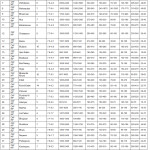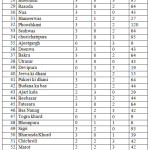Study of Various Physico-chemical Parameters of Ground Water and Water Born Diseases Spreading in Jhunjhunu District of Rajasthan
Suruchi Gupta and Praveen Kumar
Department of Chemistry, Government Dungar College, Bikaner - 334 001, India.
Article Received on :
Article Accepted on :
Article Published : 31 Dec 2012
The Jhunjhunu Block has broad spectrum of ground water quality problems. The various water borne diseases spreading in the area are Cholera, Dysentery and Hepatitis, Fluorosis, Blue Baby syndrome etc. Large no. of people are suffering due to prevailing water born diseases. For this purpose, a broad study on estimation of ground water quality was conducted in Jhunjhunu district and various parameters viz. pH, EC, TDS, Alkalinity, Total Hardness, Cl–, SO42-and total coliform bacteria were analysed Analysis shows that many of the parameters are present beyond the prescribed limits of ISI and are causing fatal problems for live hood.
KEYWORDS:Ground water; water borne diseases; Toxicity
Download this article as:| Copy the following to cite this article: Gupta S, Kumar P. Study of Various Physico-chemical Parameters of Ground Water and Water Born Diseases Spreading in Jhunjhunu District of Rajasthan. Orient J Chem 2012;28(4). |
| Copy the following to cite this URL: Gupta S, Kumar P. Study of Various Physico-chemical Parameters of Ground Water and Water Born Diseases Spreading in Jhunjhunu District of Rajasthan. Available from: http://www.orientjchem.org/?p=22891 |
Introduction
Jhunjhunu district has a dry climate with hot summer. In summer, sand storms are a characteristic feature of the district. The cold season starts by the middle of november and continues till the beginning of march. The hot season follows thereafter and extends up to the end of june. The south-west monsoon is from july to mid september. The temperature varies from 10c to 480c while the mean temperature is 240c. The normal rainfall in the district is about 500 mm/year.
There are 8 blocks in the Jhunjhunu district and all the blocks have their unique geological, historical and cultural features. Khetri and Udaipurwati are rocky while Chrawa and Nawalgarh are plain land having great agricultural and irrigational dependence on ground water. Alsisar block is totally desert with saline ground water and no irrigation. Surajgarh and Buhana also depend on ground water but the ground water potential in these blocks is very low. The Jhunjhunu block comprises of the above mentioned features and has broad spectrum of ground water quality problems. The area receives scanty rain fall and has many water quality problems. Some of them are Hepatitis, Dysentry, Chloera, Fluorosis, Blue Baby Syndrome etc. Due to these reasons, the area of Jhunjhunu block was chosen for this research study.
Experimental
In the present study, the Jhunjhunu block of the Jhunjhunu district was selected. From 136 villages (38 Panchayat) of Jhunjhunu block, 269 water samples were collected from different locations/villages. The samples were collected during 2009 (Jan) -2012 (Jan) from tubewells and pumps present in these areas. These samples were collected in wide mouth plastic bottles. before collection bottles were sequentially washed with water, detergent and soaked in 1% nitric acid for 24 hours, then again washed with clean water.1-6After collecting, samples were analyzed by the following methods :
pH by pH meteric method
EC by conductometeric method
Alkalinity, hardness and chloride by Titrameteric method.
Sulphate by Turbidimetry method
Calcium by titrametric method.
Bacteriological media method
Result And Discussion
The values of various parameters of ground water is summarized in the table given below.
 |
Table 1 Click here to View table |
 |
Table 2 Click here to View table |
MPN- Most Probable Number
pH
The pH range of 6.5 to 8.3 is normally acceptable. All the 269 samples were found in the pH range 7.2 to 8.5. On the basis of pH, it can be said that the ground water under investigated area was found to be potable and within desirable limits.
EC
As significance of conductivity, measurements are essential to indicate concentration of ionizable substances dissolved in water. In the present study, E.C. of the collected water samples was lying in the range 550 to 3400 Microsimens/cm. The permissible limit for EC is 2100 ms/cm. The analysis shows that some of the water samples have EC, greater than permissible limits.
TDS
For drinking water, the desirable concentration of TDS is less than 500ppm and maximum allowable limit is 1500ppm. If the TDS value exceeds 2000ppm, definite laxative effects are observed in those not accustomed to such salinity.
During the study, it was observed that out of 269 water samples collected, 59 water samples have more than 1500 ppm while 10 samples have TDS more than 2000 ppm.
Calcium
In normal potable ground water, calcium should have concentration between 10ppm to 100ppm and within this limit, it has no effect on the health of humans and animals . In the present study, the concentration of calcium hardness (as CaCO3) ranged between 30 ppm to 1200 ppm. As per WHO and ISI standards for drinking water, the desirable calcium (as Ca+2) concentration is 75ppm. High range of calcium is responsible for Heart stroke as well as for the formation of kidney stones.
Magnesium
In the present investigation, the concentration of magnesium hardness (as CaCO3) was found between 50 ppm to 1200 ppm in study areas while maximum relaxable limit of magnesium in drinking water is 100ppm as fixed by ISI and ICMR. Due to large amount of magnesium, chances of heart diseases occurring rises up.
Alkalinity
Bicarbonates, carbonates & hydroxides contribute essentially to the alkalinity or acid neutralizing power of water. Other constituents, namely, borates, phosphates, silicates and anionic matter, contribute alkalinity but these are usually of little significance.
During present investigation, the bicarbonate concentration was found between 100 ppm to 580 ppm.
Chloride
In the present research investigation, the chloride concentration was observed in between 30 ppm to 580 ppm. As per ISI standards, the highest desirable limit of chloride for drinking water is kept at 250ppm and maximum permissible limit is 1000ppm.
Sulphate
During the study, sulphate concentration varied from 10 ppm to 95 ppm. Indian council of medical Research has fixed the maximum permissible limit for drinking water which should not be more than 400ppm. Therefore, on the basis of these limits, it can be said that the sulphate concentration in ground water was found within the desirable limit of drinking water standards.
Hardness
As per ICMR and WHO standards, water for domestic use should not contain more than 80ppm hardness. During research investigation, it was noted that in 36.30% of total water samples, hardness was found more than 150ppm and in 12.73% samples, it was reported more than 500ppm.
Total Coliform Bacteria
Coliform bacteria are commonly found in soil, on vegetation, and in surface water.
They also live in the intestines of warm-blooded animals and humans. Some coliform bacteria strains can survive in soil and water for long periods of time. Coliform bacteria will not likely cause illness. However, because coliform bacteria are most commonly associated with sewage or surface waters, the presence of coliform bacteria in drinking water indicates that other disease-causing organisms (pathogens) are also present in the water system. There are three different groups of coliform bacteria; each has a different level of risk.
Total coliform, fecal coliform, and E. coli
Total coliform bacteria are commonly found in the environment (e.g. soil or vegetation) and are generally harmless
Fecal coliform bacteria are a sub-group of the total coliform group. They appear in great quantities in the intestines and feces of people and animals.
E. coli is a subgroup of the fecal coliform group. Most E. coli are harmless and are found in great quantities in the intestines of people and warm-blooded animals. Some strains, however, may cause illness. The presence of E. coli in a drinking water sample almost always indicates recent fecal contamination meaning that there is a greater risk that pathogens are present.7
As per ISI standard, maximum permissible limit for drinking water should not be more than 10 coliform/100 ml. During Analysis, MPN (Most Probable Number) was found to be in the range 4 to 120/100 ml. The value of MPN is very high. The presence of coliform bacteria in drinking water indicates that other disease causing pathogens are also present in the water system.
Due to toxicity range of various parameters, water born diseases are spreading in area. Water borne diseases are infectious which spread primarily through contaminated water. Though these diseases are spread either directly or through flies or filth, water is the chief medium for the spreading of these diseases and hence they are termed as water borne diseases. These diseases are more prevalent in areas with poor sanitary conditions.
A survey was conducted in 269 villages during 2009 (Jan) to 2012 (Jan). The information was collected from 50 Govt. hospitals running in these areas. Cholera, Dysentery, Hepatitis, were commonly found in the study area.
Cholera
Spread by the bacterium vibrio cholerae. When drinking water gets contaminated with bacterium, it causes cholera. In severe forms, it is known to be one of the most rapidly fatal illnesses. The symptoms include very watery diarrhea, nausea, cramps, nosebleed, rapid pulse, vomiting and hyporolemic shock.8 In severe cases, death can occur in 12-18 hours. It was found that 1270 patients were affected by the cholera.
Dysentery
Caused by a number of species in the genera shigella and salmonella, with the most common being shigella dysenteriae. When water gets contaminated with bacterium it causes dysentery. Frequent passage of faeces with blood and /or mucus and in some cases, vomiting of blood are the symptoms of this disease.9 It was found that 1548 patients were affected by the Dysentery.
Hepatitis
A group of viruses known as the hepatitis viruses, cause most cases of hepatitis but it can also be due to toxins (alcohol, certain medications some industrial organic solvents and plants), other infections and autoimmune disease. Initial features may include malaise, muscle and joint aches, fever, nausea or vomiting, diarrhea and headache. In acute hepatitis, symptoms include loss of appetite, dark urine, yellowing of the eyes and skin and abdominal discom fort.10 It was found that 350 patients were effected by the Hepatitis.
From the above study it is concluded that water of this area is not potable for drinking purpose, therefore, it should be used after proper treatment which includes Reverse osmosis, water softening, Ion exchange resin devices & Defluoridation of water.
References
- R.S. Ambarht & R.K. Ambasht, Environment & pollution (an ecological approach) students friends & Co. 2nd Edition. Varanasi Page No. 7 (1992).
- A.K. De Environmental Chemistry, New age international Publisher, 5th Edition Page 187 (2003).
- Berkant odemis, Mustafa Kemal Sangum & Dursun Butyktas, Asian Journal of Chemistry Vol. 19, No. 1 Page 711 (2007)
- M.M. Saxena. Environmental analysis water, soil and Air, Agro Botanical Publishers (India), 1990.
- Boug Bailey, Ted Bilder b ock and Dick Bir : Water consideration for container production of plants.
- N. Zieslin : IsHS Acta Horticulture 1361 International symposium on New Cultivation systems on Green House.
- Michigan Department of Environmental Quality water Division, Groundwater Section “Colliform Bacteria and Well Water Sampling.
- Ponagri S. Shyam R. & Joshi. S.N., J. Indian Association. Env. Mgmt., 27 (2000) 16.
- World Health Organization ; Guidelines for drinking water quality vol. I. Geneva (1983)
- Mrs. Deepmal Joshi & Dr. Seema Sharma. Basic Environment Engineering book 47-4.48 (2009).

This work is licensed under a Creative Commons Attribution 4.0 International License.









